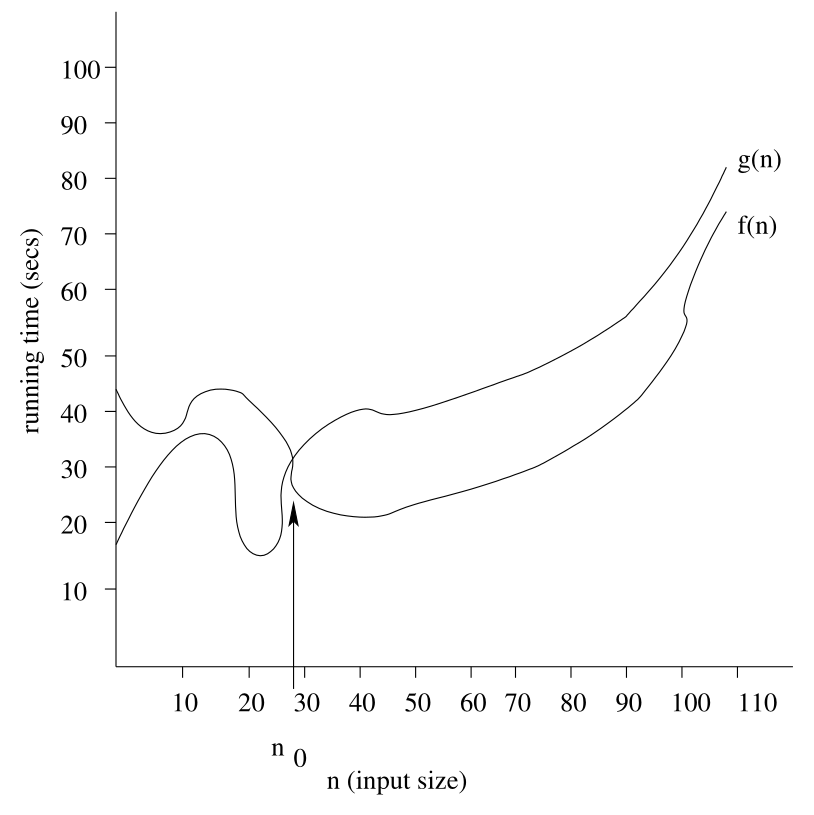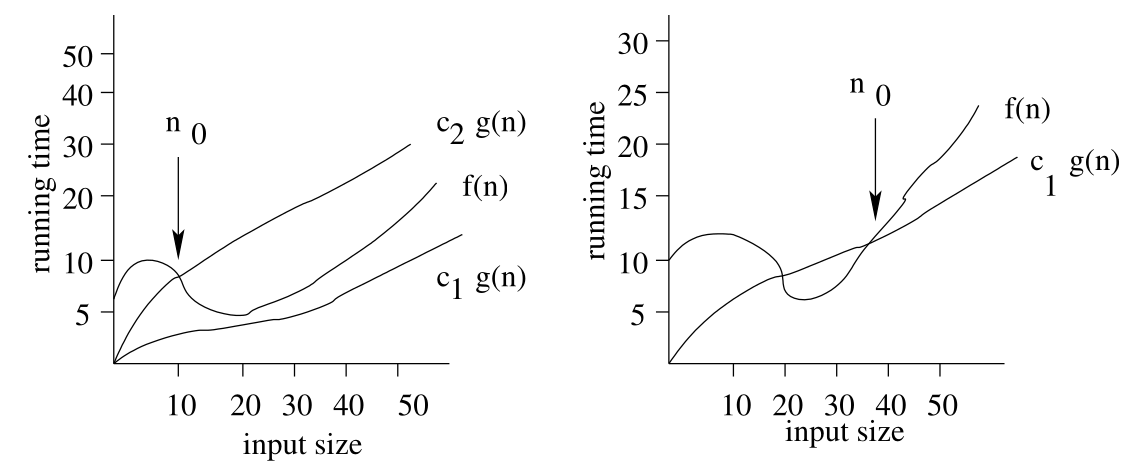Asymptotic Notation
This type of notation allows for the characterisation of the main factors affecting running time.
Big-O Notation
Given two positive functions (algorithms) $f(n)$ and $g(n)$, defined on non-negative integers, we say:
\[f(n) \text{ is } O(g(n))\]or equivalently:
\[f(n) \in O(g(n))\]if there are constants $c$ and $n_0$ such that:
\[\forall n\geq n_0, f(n)\leq c\cdot g(n)\]We want to see what it takes to make $g$ be greater than $f$.
This can also be represented in the following graph:

Big-O Example
Consider the example of:
\[7n - 4\in O(n)\]To validate this we need to find constants $c$ and $n_0$ such that:
\[\forall n\geq n_0, 7n-4\leq cn\]We could choose the values:
- $c=7$
- $n_0=1$
In order to satisfy the inequality we could have chosen any real numbeer $c\geq7$ and any integer $n_0\geq1$.
There are additional big-O examples in the slides.
$\Omega(n)$ & $\Theta(n)$ Notation
-
We say that $f(n)$ is $\Omega(g(n))$ (big-Omega) if there are real constants $c$ and $n_0$ such that:
\[\forall n\geq n_0 f(n)\geq cg(n)\] -
We say the $f(n)$ is $\Theta(g(n))$ (big-Theta) if $f(n)$ is $\Omega(g(n))$ and $f(n)$ is also $O(g(n))$.
You can see and example of this in the following graphs:

Renter’s Dilemma
Consider that to rent a film it costs $x$ but to buy it, it costs $10\times x$. We want to decide when would be the best time to buy the film.
Online vs. Offline Algorithms
- Online Setting - Requests arrive sequentially and upon arrival they must be dealt with immediately.
- Offline Setting - The entire sequence of events are given and the optimal solution must be chosen.
Competitive Analysis
This is the process of comparing a given online algorithm $A$ to an optimal offline algorithm $OPT$.
We can say that, given a sequence of requests $R=(r_1,r_2,\ldots,r_n)$, the costs of using either algorithm are calculated like so:
- cost($OPT,R$)
- cost($A, R$)
Algorithm $A$ is c-competitive, for some $c\geq1$, for $R$ if:
\[\text{cost}(A,r)\leq c\cdot \text{cost}(OPT,R)+b\]for some constant $b>0$.
If $A$ is c-competitive for ever sequence $R$, then we say that $A$ is c-competitive:
- $c$ is the competitive ratio.
If $b=0$, then $A$ is strictly c-competitive.
Renters Dilemma Example
Consider the following strategy for an online algorithm:
You rent the film every time you want to watch it.
- This will cause you to spend $n\times x$ which could be up to $\frac {n\times x} {10}$ more pounds than is optimal.
A more optimal solution would be to rent 10 times and then buy the film.
- In this case you would spend at most 2 times more than an offline strategy. You can call this 2-competitive.
You can find an analysis of this at slide 50.